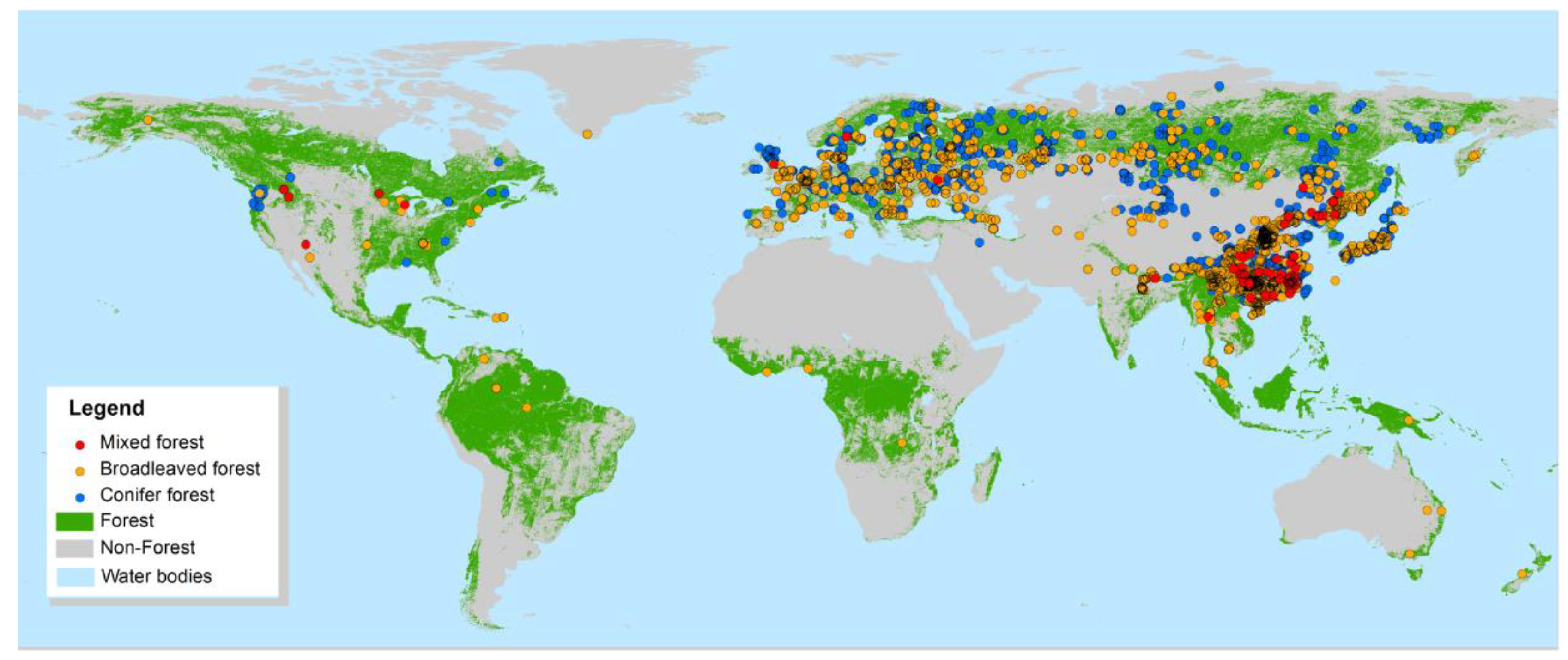Separating Regressions for Model Fitting to Reduce the Uncertainty in Forest Volume-Biomass Relationship
Abstract
1. Introduction
1.1. Forest Biomass Estimation
1.2. Uncertainty in the Estimation
1.3. Study Objectives
2. Materials and Methods
2.1. Strategy
2.2. Parametric Equations
2.3. Parameter Improvement
2.4. Data Description
2.5. Coverage Area of Observations
2.6. Sampling Simulation
3. Results
3.1. Comparison of Two Relationships
3.2. Model Test
3.3. Comparison Between Biomass Estimates
4. Discussion
4.1. Model Test
4.2. Wood Density Estimation
4.3. Uncertainties
5. Conclusions
Supplementary Materials
Author Contributions
Funding
Acknowledgments
Conflicts of Interest
References
- Mitchard, E.T.A. The tropical forest carbon cycle and climate change. Nature 2018, 559, 527–534. [Google Scholar] [CrossRef] [PubMed]
- Rodriguez-Veiga, P.; Quegan, S.; Carreiras, J.; Persson, H.J.; Fransson, J.E.S.; Hoscilo, A.; Ziolkowski, D.; Sterenczak, K.; Lohberger, S.; Stangel, M.; et al. Forest biomass retrieval approaches from earth observation in different biomes. Int. J. Appl. Earth Obs. Geoinf. 2019, 77, 53–68. [Google Scholar] [CrossRef]
- Lu, D. The potential and challenge of remote sensing-based biomass estimation. Int. J. Remote Sens. 2006, 27, 1297–1328. [Google Scholar] [CrossRef]
- Seidel, D.; Fleck, S.; Leuschner, C.; Hammett, T. Review of ground-based methods to measure the distribution of biomass in forest canopies. Ann. For. Sci. 2011, 68, 225–244. [Google Scholar] [CrossRef]
- Dobbertin, M.; Neumann, M.; Schroeck, H.-W. Chapter 10—Tree Growth Measurements in Long-Term Forest Monitoring in Europe. In Developments in Environmental Science; Elsevier: Amsterdam, The Netherlands, 2013; pp. 183–204. [Google Scholar]
- Liang, X.; Kukko, A.; Hyyppa, J.; Lehtomaki, M.; Pyorala, J.; Yu, X.; Kaartinen, H.; Jaakkola, A.; Wang, Y. In-situ measurements from mobile platforms: An emerging approach to address the old challenges associated with forest inventories. ISPRS J. Photogramm. Remote Sens. 2018, 143, 97–107. [Google Scholar] [CrossRef]
- Mayaka, T.B.; Eba, R.; Momo, S.T. Construction of multi species allometric equations: Is there a statistical palliative for destructive tree sampling? J. Trop. For. Sci. 2017, 29, 282–296. [Google Scholar]
- Weiskittel, A.R.; MacFarlane, D.W.; Radtke, P.J.; Affleck, D.L.R.; Temesgen, H.; Woodall, C.W.; Westfall, J.A.; Coulston, J.W. A Call to Improve Methods for Estimating Tree Biomass for Regional and National Assessments. J. For. 2015, 113, 414–424. [Google Scholar] [CrossRef]
- Addo-Danso, S.D.; Prescott, C.E.; Smith, A.R. Methods for estimating root biomass and production in forest and woodland ecosystem carbon studies: A review. For. Ecol. Manag. 2016, 359, 332–351. [Google Scholar] [CrossRef]
- Paul, K.I.; Larmour, J.; Specht, A.; Zerihun, A.; Ritson, P.; Roxburgh, S.H.; Sochacki, S.; Lewis, T.; Barton, C.V.M.; England, J.R.; et al. Testing the generality of below-ground biomass allometry across plant functional types. For. Ecol. Manag. 2019, 432, 102–114. [Google Scholar] [CrossRef]
- Somogyi, Z.; Cienciala, E.; Mäkipää, R.; Muukkonen, P.; Lehtonen, A.; Weiss, P. Indirect methods of large-scale forest biomass estimation. Eur. J. For. Res. 2007, 126, 197–207. [Google Scholar] [CrossRef]
- Brown, S.L.; Lugo, A. Biomass of Tropical Forests: A New Estimate Based on Forest Volumes Author (s): Sandra Brown and Ariel E. Lugo Published by: American Association for the Advancement of Science Stable. Science 1984, 223, 1290–1293. [Google Scholar] [CrossRef] [PubMed]
- Ver Planck, N.R.; MacFarlane, D.W. A vertically integrated whole-tree biomass model. Trees Struct. Funct. 2015, 29, 449–460. [Google Scholar] [CrossRef]
- Neumann, M.; Moreno, A.; Mues, V.; Härkönen, S.; Mura, M.; Bouriaud, O.; Lang, M.; Achten, W.M.J.; Thivolle-Cazat, A.; Bronisz, K.; et al. Comparison of carbon estimation methods for European forests. For. Ecol. Manag. 2016, 361, 397–420. [Google Scholar] [CrossRef]
- Jucker, T.; Caspersen, J.; Chave, J.; Antin, C.; Barbier, N.; Bongers, F.; Dalponte, M.; van Ewijk, K.Y.; Forrester, D.I.; Haeni, M.; et al. Allometric equations for integrating remote sensing imagery into forest monitoring programmes. Glob. Chang. Biol. 2017, 23, 177–190. [Google Scholar] [CrossRef] [PubMed]
- Di Cosmo, L.; Gasparrini, P.; Tabacchi, G. A national-scale, stand-level model to predict total above-ground tree biomass from growing stock volume. For. Ecol. Manag. 2016, 361, 269–276. [Google Scholar] [CrossRef]
- Guo, Z.; Fang, J.; Pan, Y.; Birdsey, R. Inventory-based estimates of forest biomass carbon stocks in China: A comparison of three methods. For. Ecol. Manag. 2010, 259, 1225–1231. [Google Scholar] [CrossRef]
- Jenkins, J.C.; Chojnacky, D.C.; Heath, L.S.; Birdsey, R.A. National-Scale Biomass Estimators for United States Tree Species. For. Sci. 2003, 49, 12–35. [Google Scholar]
- Zianis, D.; Seura, S. Biomass and stem volume equations for tree species in Europe. Silva Fenn. Monogr. 2005, 4, 1–63. [Google Scholar]
- Muukkonen, P.; Heiskanen, J. Biomass estimation over a large area based on standwise forest inventory data and ASTER and MODIS satellite data: A possibility to verify carbon inventories. Remote Sens. Environ. 2007, 107, 617–624. [Google Scholar] [CrossRef]
- Henry, M.; Picard, N.; Trotta, C.; Manlay, R.J.; Valentini, R.; Bernoux, M.; Saint-André, L. Estimating tree biomass of sub-Saharan African forests: A review of available allometric equations. Silva Fenn. 2011, 45, 477–569. [Google Scholar] [CrossRef]
- Boudewyn, P.; Song, X.; Magnussen, S.; Gillis, M.D. Model-Based, Volume-to-Biomass Conversion for Forested and Vegetated Land in Canada; Natural Resources Canada Canadian Forest Service Pacific Forestry Centre Natural: Victoria, BC, Canada, 2007; p. 124.
- Segura, M.; Kanninen, M. Allometric models for tree volume and total aboveground biomass in a tropical humid forest in Costa Rica. Biotropica 2005, 37, 2–8. [Google Scholar] [CrossRef]
- Smith, J.E.; Heath, L.S.; Jenkins, J.C. Forest Volume-to-Biomass Models and Estimates of Mass for Live and Standing Dead Trees of US Forests; Department of Agriculture, Forest Service: Newtown Square, PA, USA, 2003; p. 57.
- Zhou, X.; Lei, X.; Peng, C.; Wang, W.; Zhou, C.; Liu, C.; Liu, Z. Correcting the overestimate of forest biomass carbon on the national scale. Methods Ecol. Evol. 2016, 7, 447–455. [Google Scholar] [CrossRef]
- Nelson, R.; Margolis, H.; Montesano, P.; Sun, G.; Cook, B.; Corp, L.; Andersen, H.E.; deJong, B.; Pellat, F.P.; Fickel, T.; et al. Lidar-based estimates of aboveground biomass in the continental US and Mexico using ground, airborne, and satellite observations. Remote Sens. Environ. 2017, 188, 127–140. [Google Scholar] [CrossRef]
- Chen, Q.; Vaglio Laurin, G.; Valentini, R. Uncertainty of remotely sensed aboveground biomass over an African tropical forest: Propagating errors from trees to plots to pixels. Remote Sens. Environ. 2015, 160, 134–143. [Google Scholar] [CrossRef]
- Lu, D.; Chen, Q.; Wang, G.; Liu, L.; Li, G.; Moran, E. A survey of remote sensing-based aboveground biomass estimation methods in forest ecosystems. Int. J. Digit. Earth 2016, 9, 63–105. [Google Scholar] [CrossRef]
- Henry, M.; Besnard, A.; Asante, W.A.; Eshun, J.; Adu-Bredu, S.; Valentini, R.; Bernoux, M.; Saint-André, L. Wood density, phytomass variations within and among trees, and allometric equations in a tropical rainforest of Africa. For. Ecol. Manag. 2010, 260, 1375–1388. [Google Scholar] [CrossRef]
- Mather, A.S. Assessing the world’s forests. Glob. Environ. Chang. 2005, 15, 267–280. [Google Scholar] [CrossRef]
- Lei, X.; Tang, M.; Lu, Y.; Hong, L.; Tian, D. Forest inventory in China: Status and challenges. Int. For. Rev. 2009, 11, 52–63. [Google Scholar] [CrossRef]
- FAO. Global Forest Resources Assessment 2010; Food and Agriculture Organization of the United Nations: Rome, Italy, 2010. [Google Scholar]
- Fang, J.; Chen, A.; Peng, C.; Zhao, S.; Chi, L. Changes in forest biomass carbon storage in China between 1949 and 1998. Science 2001, 292, 2320–2322. [Google Scholar] [CrossRef]
- Pan, Y.; Luo, T.; Birdseyi, R.; Hom, J.; Melill, J. New estimates of carbon storage and sequestration in china’s forests: Effects of age-class and method on inventory-based carbon estimation. Clim. Chang. 2004, 67, 211–236. [Google Scholar] [CrossRef]
- Xu, X.; Li, K. Biomass carbon sequestration by planted forests in China. Chin. Geogr. Sci. 2010, 20, 289–297. [Google Scholar] [CrossRef]
- Zhang, C.; Ju, W.; Chen, J.M.; Zan, M.; Li, D.; Zhou, Y.; Wang, X. China’s forest biomass carbon sink based on seven inventories from 1973 to 2008. Clim. Chang. 2013, 118, 933–948. [Google Scholar] [CrossRef]
- Du, L.; Zhou, T.; Zou, Z.; Zhao, X.; Huang, K.; Wu, H. Mapping forest biomass using remote sensing and national forest inventory in China. Forests 2014, 5, 1267–1283. [Google Scholar] [CrossRef]
- Hu, H.; Wang, S.; Guo, Z.; Xu, B.; Fang, J. The stage-classified matrix models project a significant increase in biomass carbon stocks in China’s forests between 2005 and 2050. Sci. Rep. 2015, 5, 11203. [Google Scholar] [CrossRef]
- Parresol, B.R. Assessing tree and stand biomass: A review with examples and critical comparisons. For. Sci. 1999, 45, 573–593. [Google Scholar]
- Chave, J.; Muller-Landau, H.C.; Baker, T.R.; Easdale, T.A.; Steege, H.T.; Webb, C.O. Regional and phylogenetic variation of wood density across 2456 Neotropical Tree Species. Ecol. Appl. 2006, 16, 2356–2367. [Google Scholar] [CrossRef]
- Ni, J. Carbon storage in Chinese terrestrial ecosystems: Approaching a more accurate estimate. Clim. Chang. 2013, 119, 905–917. [Google Scholar] [CrossRef]
- Sileshi, G.W. A critical review of forest biomass estimation models, common mistakes and corrective measures. For. Ecol. Manag. 2014, 329, 237–254. [Google Scholar] [CrossRef]
- Temesgen, H.; Affleck, D.; Poudel, K.; Gray, A.; Sessions, J. A review of the challenges and opportunities in estimating above ground forest biomass using tree-level models. Scand. J. For. Res. 2015, 30, 326–335. [Google Scholar] [CrossRef]
- Lindner, M.; Fitzgerald, J.B.; Zimmermann, N.E.; Reyer, C.; Delzon, S.; Van Der Maaten, E.; Schelhaas, M.J.; Lasch, P.; Eggers, J.; Van Der Maaten-Theunissen, M.; et al. Climate change and European forests: What do we know, what are the uncertainties, and what are the implications for forest management? J. Environ. Manag. 2014, 146, 69–83. [Google Scholar] [CrossRef]
- Wang, J.R.; Zhong, A.L.; Kimmins, J.P. Biomass estimation errors associated with the use of published regression equations of paper birch and trembling aspen. North. J. Appl. For. 2002, 19, 128–136. [Google Scholar]
- Soderstrom, T.; Stoica, P. System Identification; Prentice Hall: New York, NY, USA, 1989. [Google Scholar]
- Usoltsev, V.A. Forest Biomass and Primary Production Database for Eurasia, 2nd ed.; CD-ve.; Ural State Forest Engineering University: Yekaterinburg, Russia, 2013. [Google Scholar]
- Luo, Y.; Wang, X.; Zhang, X.; Lu, F. Biomass and Its Allocation of Forest Ecosystems in China; Chinese Forestry Publishing House Press: Beijing, China, 2013. [Google Scholar]
- Cannell, M.G.R. World Forest Biomass and Primary Production Data; Academic Press: London, UK, 1982. [Google Scholar]
- Gong, P.; Wang, J.; Yu, L.; Zhao, Y.; Zhao, Y.; Liang, L.; Niu, Z.; Huang, X.; Fu, H.; Liu, S.; et al. Finer resolution observation and monitoring of global land cover: First mapping results with Landsat TM and ETM+ data. Int. J. Remote Sens. 2013, 34, 2607–2654. [Google Scholar] [CrossRef]
- Yu, L.; Wang, J.; Li, X.; Li, C.; Zhao, Y.; Gong, P. A multi-resolution global land cover dataset through multisource data aggregation. Sci. China Earth Sci. 2014, 57, 2317–2329. [Google Scholar] [CrossRef]
- Zanne, A.; Lopez-Gonzalez, G.; Coomes, D.; Ilic, J.; Jansen, S.; Lewis, S.; Miller, R.; Swenson, N.; Wiemann, M.; Chave, J. Global Wood Density Database. 2009. Available online: http://datadryad.org/handle/10255/dryad.235 (accessed on 25 September 2016).
- CMF (Chinese Ministry of Forestry). Forest Resource Report of China for Periods 2008–2012; Department of Forest Resource and Management, Chinese Ministry of Forestry: Beijing, China, 2013.
- Picard, N.; Boyemba Bosela, F.; Rossi, V. Reducing the error in biomass estimates strongly depends on model selection. Ann. For. Sci. 2015, 72, 811–823. [Google Scholar] [CrossRef]
- Harrell, F.E., Jr. Regression Modeling Strategies: With Applications to Linear Models, Logistic and Ordinal Regression, and Survival Analysis, 2nd ed.; Springer: Heidelberg, Germany, 2015; Volume 64, ISBN 9783319194240. [Google Scholar]
- Chave, J.; Condit, R.; Lao, S.; Caspersen, J.P.; Foster, R.B.; Hubbell, S.P. Spatial and temporal variation of biomass in a tropical forest: Results from a large census plot in Panama. J. Ecol. 2003, 91, 240–252. [Google Scholar] [CrossRef]
- Domke, G.M.; Woodall, C.W.; Smith, J.E.; Westfall, J.A.; McRoberts, R.E. Consequences of alternative tree-level biomass estimation procedures on US forest carbon stock estimates. For. Ecol. Manag. 2012, 270, 108–116. [Google Scholar] [CrossRef]
- Chave, J.; Réjou-Méchain, M.; Búrquez, A.; Chidumayo, E.; Colgan, M.S.; Delitti, W.B.C.; Duque, A.; Eid, T.; Fearnside, P.M.; Goodman, R.C.; et al. Improved allometric models to estimate the aboveground biomass of tropical trees. Glob. Chang. Biol. 2014, 20, 3177–3190. [Google Scholar] [CrossRef]
- Flores, O.; Coomes, D.A. Estimating the wood density of species for carbon stock assessments. Methods Ecol. Evol. 2011, 2, 214–220. [Google Scholar] [CrossRef]
- Crowther, T.W.; Glick, H.B.; Covey, K.R.; Bettigole, C.; Maynard, D.S.; Thomas, S.M.; Smith, J.R.; Hintler, G.; Duguid, M.C.; Amatulli, G.; et al. Mapping tree density at a global scale. Nature 2015, 525, 201–205. [Google Scholar] [CrossRef]
- Chave, J.; Coomes, D.; Jansen, S.; Lewis, S.L.; Swenson, N.G.; Zanne, A.E. Towards a worldwide wood economics spectrum. Ecol. Lett. 2009, 12, 351–366. [Google Scholar] [CrossRef]
- Chave, J.; Condit, R.; Aguilar, S.; Hernandez, A.; Lao, S.; Perez, R. Error propagation and sealing for tropical forest biomass estimates. Philos. Trans. R. Soc. B Biol. Sci. 2004, 359, 409–420. [Google Scholar] [CrossRef]
- Baker, T.R.; Phillips, O.L.; Malhi, Y.; Almeida, S.; Arroyo, L.; Di Fiore, A.; Erwin, T.; Higuchi, N.; Killeen, T.J.; Laurance, S.G.; et al. Increasing biomass in Amazonian forest plots. Philos. Trans. R. Soc. B Biol. Sci. 2004, 359, 353–365. [Google Scholar] [CrossRef]
- Visser, M.D.; Bruijning, M.; Wright, S.J.; Muller-Landau, H.C.; Jongejans, E.; Comita, L.S.; de Kroon, H. Functional traits as predictors of vital rates across the life cycle of tropical trees. Funct. Ecol. 2016, 30, 168–180. [Google Scholar] [CrossRef]
- Woodall, C.W.; Heath, L.S.; Domke, G.M.; Nichols, M.C. Methods and Equations for Estimating Aboveground Volume, Biomass, and Carbon for Trees in the US Forest Inventory, 2010; Department of Agriculture, Forest Service: Newtown Square, PA, USA, 2011; p. 34.
- Kojima, M.; Yamamoto, H.; Yoshida, M.; Ojio, Y.; Okumura, K. Maturation property of fast-growing hardwood plantation species: A view of fiber length. For. Ecol. Manag. 2009, 257, 15–22. [Google Scholar] [CrossRef]
- Pretzsch, H.; Biber, P.; Schütze, G.; Kemmerer, J.; Uhl, E. Wood density reduced while wood volume growth accelerated in Central European forests since 1870. For. Ecol. Manag. 2018, 429, 589–616. [Google Scholar] [CrossRef]
- Denslow, J.S. Gap partitioning among tropical rainforest trees. Biotropica 1980, 12, 47–55. [Google Scholar] [CrossRef]
- Westfall, J.A.; Patterson, P.L. Measurement variability error for estimates of volume change. Can. J. For. Res. 2008, 37, 2201–2210. [Google Scholar] [CrossRef]
- Berger, A.; Gschwantner, T.; McRoberts, R.E.; Schadauer, K. Effects of measurement errors on individual tree stem volume estimates for the Austrian national forest inventory. For. Sci. 2014, 60, 14–24. [Google Scholar] [CrossRef]
- McRoberts, R.E.; Westfall, J.A. The effects of uncertainty in individual tree volume model predictions on the uncertainty of large area volume estimates the method. For. Sci. 2014, 60, 34–42. [Google Scholar]
- Reich, P.B.; Luo, Y.; Bradford, J.B.; Poorter, H.; Perry, C.H.; Oleksyn, J. Temperature drives global patterns in forest biomass distribution in leaves, stems, and roots. Proc. Natl. Acad. Sci. USA 2014, 111, 13721–13726. [Google Scholar] [CrossRef]
- Jenkins, J.C.; Chojnacky, D.C.; Heath, L.S.; Birdsey, R.A. Comprehensive Database of Diameter-Based Biomass Regressions for North American Tree Species; Department of Agriculture, Forest Service: Newtown Square, PA, USA, 2004; p. 45.
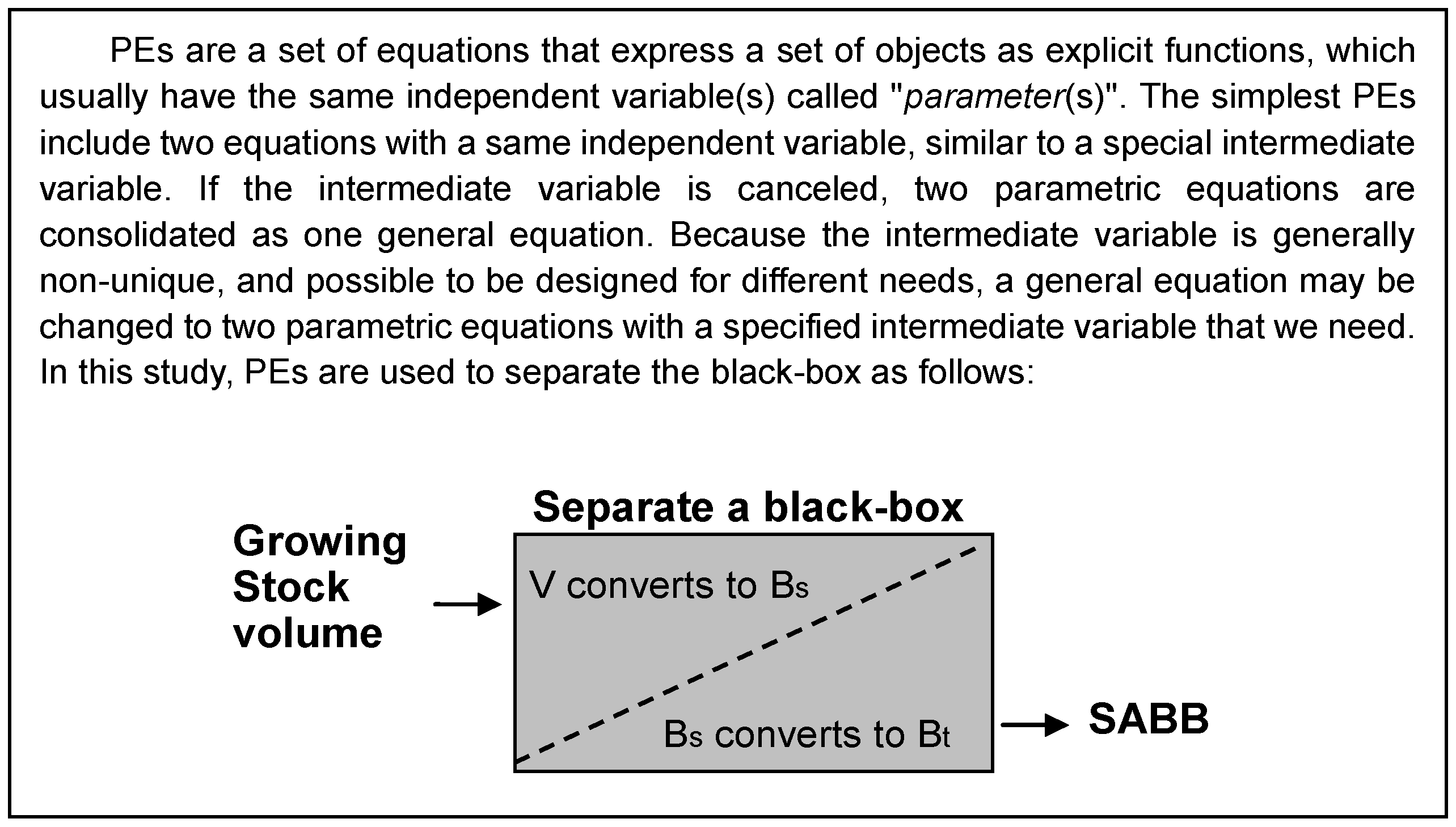
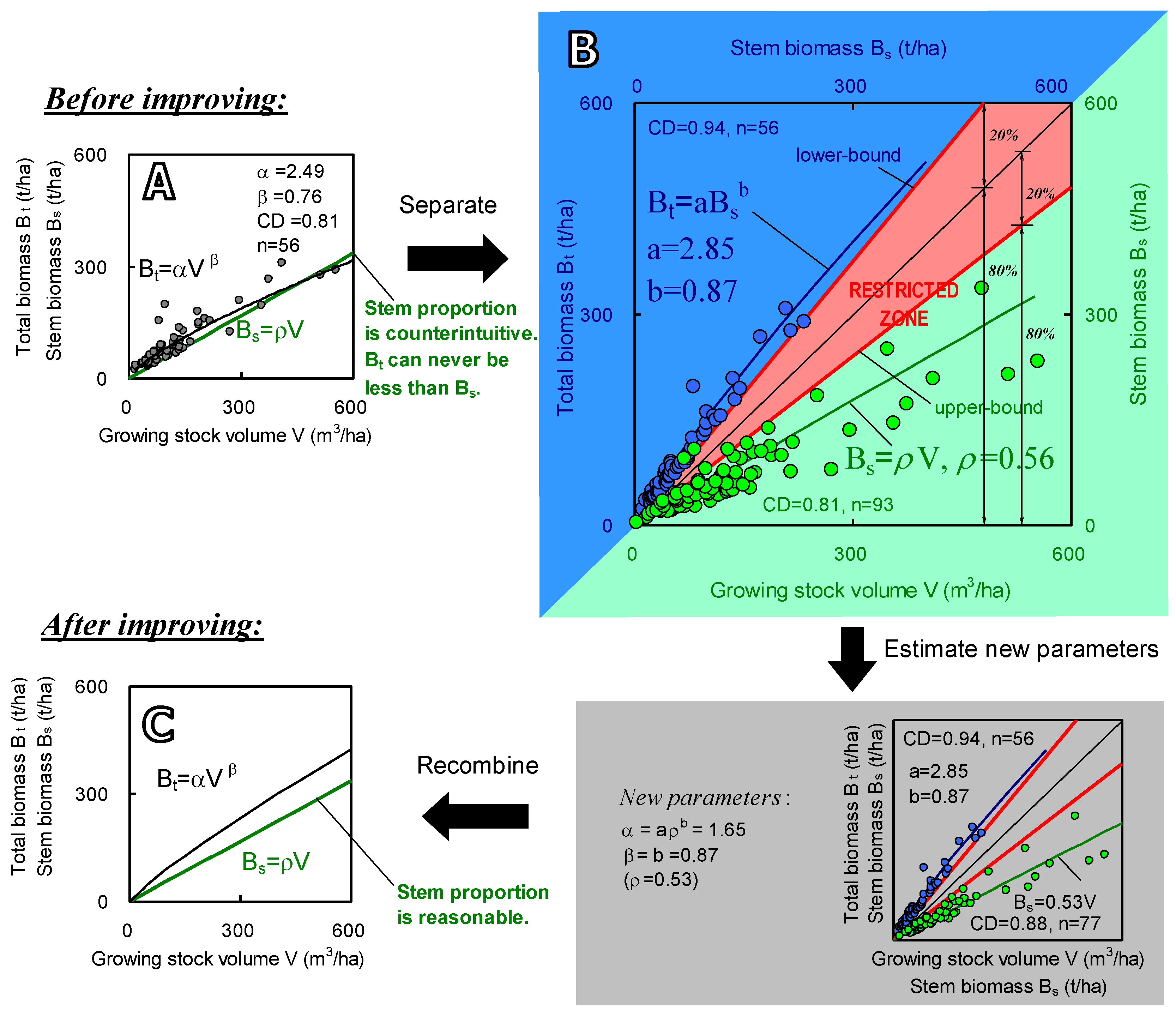
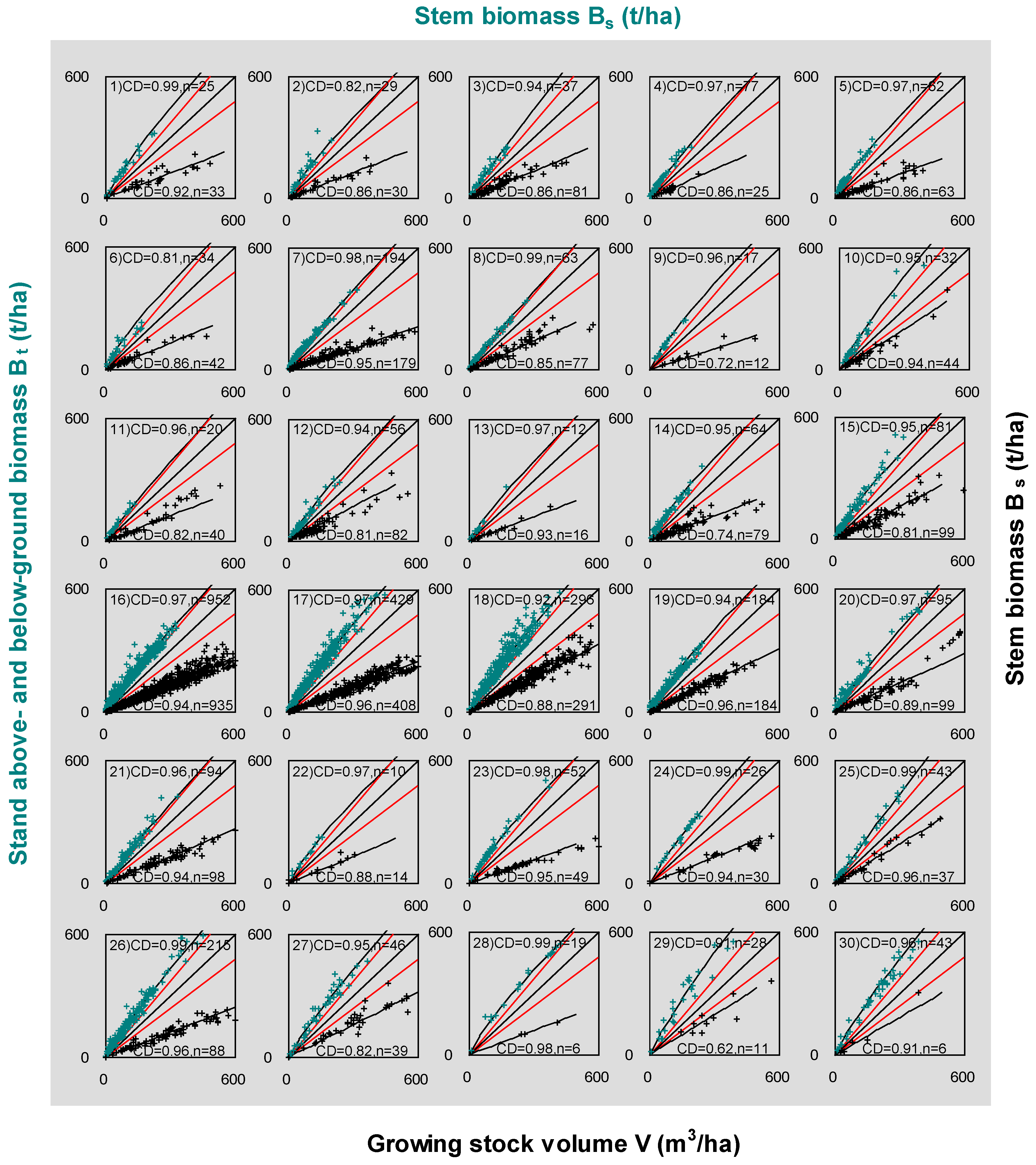
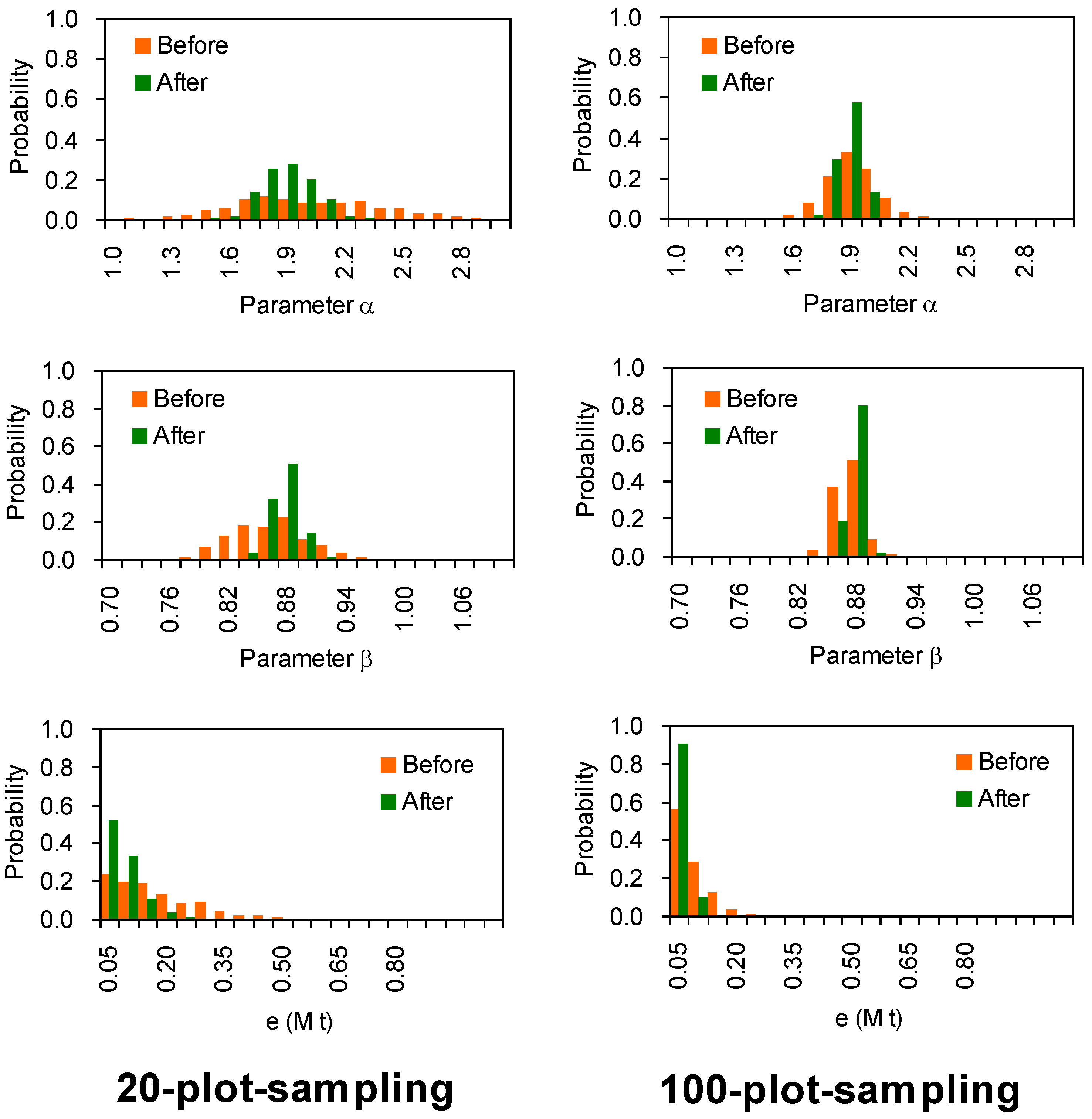
| No. | Species or Types * | After Improving | After Data Cleaning | Difference on α | |||||||
|---|---|---|---|---|---|---|---|---|---|---|---|
| A † | B † | ρ‡ | SD | Recombined α | ρ§ | SD | Bias on ρ | Recombined α | |||
| 1 | Abies and Picea | 3.32 | 0.86 | 0.41 | 1.9% | 1.54 | 0.41 | 1.6% | −0.2% | 1.54 | −0.1% |
| 2 | Cupressus | 3.2 | 0.85 | 0.42 | 3.9% | 1.53 | 0.43 | 3.1% | −3.4% | 1.57 | −2.9% |
| 3 | Larix | 1.91 | 0.95 | 0.45 | 2.3% | 0.89 | 0.45 | 2.1% | 0.0% | 0.89 | 0.0% |
| 4 | Pinus tabulaeformis | 2.9 | 0.86 | 0.47 | 3.5% | 1.51 | 0.47 | 3.5% | 0.0% | 1.51 | 0.0% |
| 5 | Pinus koraiensis and other temperate pines | 3.4 | 0.84 | 0.39 | 3.0% | 1.54 | 0.39 | 2.9% | −0.8% | 1.55 | −0.6% |
| 6 | Pinus yunnanensis and other subtropical pines | 4.5 | 0.8 | 0.43 | 3.6% | 2.29 | 0.45 | 3.0% | −4.7% | 2.38 | −3.7% |
| 7 | Cunninghamia lanceolata | 2.52 | 0.89 | 0.35 | 1.0% | 0.99 | 0.36 | 0.9% | −3.4% | 1.02 | −3.0% |
| 8 | Pinus massoniana | 1.96 | 0.93 | 0.47 | 2.8% | 0.97 | 0.46 | 2.3% | 2.1% | 0.95 | 1.9% |
| 9 | Other conifer trees | 3.8 | 0.83 | 0.35 | 5.5% | 1.59 | 0.4 | 4.8% | −14.2% | 1.78 | −11.7% |
| 10 | Oaks and other deciduous trees | 3.15 | 0.87 | 0.67 | 2.5% | 2.22 | 0.65 | 2.2% | 3.7% | 2.15 | 3.2% |
| 11 | Populus and Betula | 2.07 | 0.92 | 0.41 | 3.8% | 0.91 | 0.41 | 3.3% | 0.3% | 0.91 | 0.3% |
| 12 | Eucalyptus and other fast-growing trees | 2.85 | 0.87 | 0.56 | 2.7% | 1.72 | 0.56 | 2.3% | 0.3% | 1.72 | 0.2% |
| 13 | Soft broadleaved trees | 2.78 | 0.87 | 0.4 | 4.2% | 1.25 | 0.41 | 3.4% | −1.7% | 1.27 | −1.5% |
| 14 | Mixed conifer and deciduous forests | 4.28 | 0.8 | 0.41 | 3.3% | 2.1 | 0.42 | 2.8% | −3.4% | 2.15 | −2.7% |
| 15 | Other hard broadleaved trees | 4.27 | 0.8 | 0.48 | 3.0% | 2.37 | 0.47 | 2.1% | 1.8% | 2.34 | 1.4% |
| 16 | Pinus | 2.57 | 0.89 | 0.44 | 0.5% | 1.24 | 0.44 | 0.5% | 0.0% | 1.24 | 0.0% |
| 17 | Abies and Picea | 2.98 | 0.87 | 0.41 | 0.6% | 1.37 | 0.41 | 0.6% | −0.7% | 1.38 | −0.6% |
| 18 | Fagus, Acer, Carpinus and Quercus | 2.9 | 0.88 | 0.54 | 0.9% | 1.69 | 0.53 | 0.8% | 0.9% | 1.67 | 0.8% |
| 19 | Betula | 3.14 | 0.85 | 0.51 | 0.8% | 1.77 | 0.51 | 0.7% | 0.5% | 1.76 | 0.4% |
| 20 | Larix | 2.22 | 0.91 | 0.47 | 2.4% | 1.12 | 0.47 | 2.4% | 0.0% | 1.12 | 0.0% |
| 21 | Alnus and Populus | 2.13 | 0.91 | 0.44 | 1.2% | 1.01 | 0.44 | 1.2% | 0.0% | 1.01 | 0.0% |
| 22 | Tilia | 3.42 | 0.84 | 0.44 | 5.1% | 1.72 | 0.44 | 5.1% | 0.0% | 1.72 | 0.0% |
| 23 | Castanopsis, Cryptomeria, and Pseudotsuga | 3.39 | 0.84 | 0.39 | 1.3% | 1.54 | 0.4 | 1.1% | −1.8% | 1.56 | −1.5% |
| 24 | Chamaecyparis obtusa | 3.23 | 0.86 | 0.43 | 1.6% | 1.56 | 0.43 | 1.6% | 0.0% | 1.56 | 0.0% |
| 25 | Eucalyptus and other fast-growing trees | 1.88 | 0.96 | 0.64 | 2.2% | 1.22 | 0.63 | 2.1% | 1.6% | 1.21 | 1.5% |
| 26 | Conifer | 2.59 | 0.9 | 0.41 | 1.2% | 1.16 | 0.41 | 1.2% | −0.2% | 1.16 | −0.2% |
| 27 | Broadleaved | 2.9 | 0.88 | 0.53 | 2.8% | 1.66 | 0.53 | 2.7% | 0.0% | 1.66 | 0.0% |
| 28 | Mixed | 4.04 | 0.81 | 0.4 | 2.0% | 1.92 | 0.4 | 2.0% | 0.0% | 1.92 | 0.0% |
| 29 | Tropical | 3.71 | 0.86 | 0.65 | 7.0% | 2.56 | 0.62 | 4.6% | 4.5% | 2.46 | 3.9% |
| 30 | Tropical | 3.3 | 0.87 | 0.61 | 7.4% | 2.15 | 0.61 | 7.3% | 0.2% | 2.14 | 0.2% |
| Assumptions of Plot Population and Sampling | Before Improving | After Improving | Simulation Times | |||||
|---|---|---|---|---|---|---|---|---|
| α | β | e * (Mt) | α | β | e * (Mt) | |||
| Homogeneous stands. All stands have same wood density ρ = 0.59 (t m−3) without any biomass measurement errors† | ||||||||
| 20 plots | Average (μ) ‡ | 1.79 | 0.87 | 0.0 | 1.79 | 0.87 | 0.0 | 500 |
| SD (σ) | 0.0 | 0.0 | - | 0.0 | 0.0 | - | ||
| 100 plots | Average (μ) ‡ | 1.79 | 0.87 | 0.0 | 1.79 | 0.87 | 0.0 | 500 |
| SD (σ) | 0.0 | 0.0 | - | 0.0 | 0.0 | - | ||
| Heterogeneous stands. Wood densities (ρ) are randomly distributed for each plot; measurement errors occur§ | ||||||||
| 20 plots | Average (μ) | 1.99 | 0.86 | 0.16 | 1.83 | 0.87 | 0.08 | 500 |
| SD (σ) | 0.385 | 0.038 | - | 0.131 | 0.014 | - | ||
| 100 plots | Average (μ) | 1.92 | 0.87 | 0.10 | 1.88 | 0.88 | 0.06 | 500 |
| SD (σ) | 0.124 | 0.013 | - | 0.06 | 0.006 | - | ||
© 2019 by the authors. Licensee MDPI, Basel, Switzerland. This article is an open access article distributed under the terms and conditions of the Creative Commons Attribution (CC BY) license (http://creativecommons.org/licenses/by/4.0/).
Share and Cite
Liu, C.; Zhou, X.; Lei, X.; Huang, H.; Zhou, C.; Peng, C.; Wang, X. Separating Regressions for Model Fitting to Reduce the Uncertainty in Forest Volume-Biomass Relationship. Forests 2019, 10, 658. https://doi.org/10.3390/f10080658
Liu C, Zhou X, Lei X, Huang H, Zhou C, Peng C, Wang X. Separating Regressions for Model Fitting to Reduce the Uncertainty in Forest Volume-Biomass Relationship. Forests. 2019; 10(8):658. https://doi.org/10.3390/f10080658
Chicago/Turabian StyleLiu, Caixia, Xiaolu Zhou, Xiangdong Lei, Huabing Huang, Carl Zhou, Changhui Peng, and Xiaoyi Wang. 2019. "Separating Regressions for Model Fitting to Reduce the Uncertainty in Forest Volume-Biomass Relationship" Forests 10, no. 8: 658. https://doi.org/10.3390/f10080658
APA StyleLiu, C., Zhou, X., Lei, X., Huang, H., Zhou, C., Peng, C., & Wang, X. (2019). Separating Regressions for Model Fitting to Reduce the Uncertainty in Forest Volume-Biomass Relationship. Forests, 10(8), 658. https://doi.org/10.3390/f10080658





